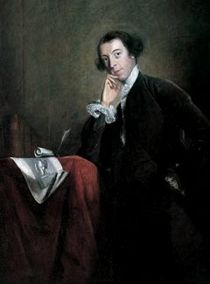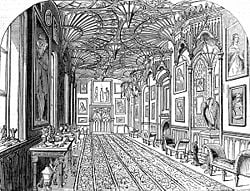Horace Walpole, 4th Earl of Orford
| Horace Walpole | |
 Horace Walpole by Joshua Reynolds 1756
National Portrait Gallery, collection London . | |
| Born | September 24 1717 |
|---|---|
| Died | March 2 1797 (aged 79) |
| Occupation | Author, Politician |
| Parents | Robert Walpole and Catherine Shorter |
Horace Walpole, 4th Earl of Orford (September 24, 1717 – March 2, 1797), more commonly known as Horace Walpole, was a writer, politician, and architectural innovator. He was the youngest son of British Prime Minister Robert Walpole and the cousin of Lord Nelson. The pseudo-Gothic castle which he built at his country house, Strawberry Hill, became the showplace of England and revived the Gothic style many decades before its Victorian successors.
Walpole's more than 3,000 Letters provide insight into the intellectual side of the aristocracy of his period. His novel, The Castle of Otranto, heralded a new genre, the Gothic novel, which anticipated nineteenth-century Romanticism. Walpole's other important works include Historic Doubts on Richard III, Anecdotes of Painting in England, and Reminiscences.
Biography
Horace Walpole was born in London, the youngest son of British Prime Minister Robert Walpole. After finishing his education at Eton College and King's College, Cambridge, he toured the European continent with his friend Thomas Gray from 1739 to 1741, when the two quarreled and parted. He was elected to Parliament in 1741 and served until 1767, confining himself largely to the role of spectator and defender of the memory of his father, who died in 1745.
In 1747, Walpole acquired a country house, Strawberry Hill, near Twickenham, where he built a pseudo-Gothic castle, which became the showplace of England. Walpole's lasting architectural creation in southwest London, Strawberry Hill, revived the Gothic style many decades before its Victorian successors. This fanciful concoction of neo-Gothic began a new architectural trend.
He was reconciled with Gray in 1745, and later published his friend's Pindaric Odes, as well as many first editions of his own works from the private printing press he started at Strawberry Hill in 1757. Walpole is especially known for his letters which have great charm and polish and are invaluable pictures of Georgian England. More than 3,000 of his correspondences are extant and cover a period extending from 1732 to 1797. Among his more famous letters are with Gray, Sir Horace Mann, Thomas Chatterton, and Madame Du Deffand.
Walpole succeeded to the earldom of Orford in 1791. Besides his enthusiasm for medieval architecture and trappings, he anticipated the Romanticism of the nineteenth century with his Gothic romance, The Castle of Otranto (1765). His other important works include Historic Doubts on Richard III (1768), an attempt to rehabilitate the character of Richard; Anecdotes of Painting in England (4 vol., 1762–71); and posthumous works, Reminiscences (1798) and memoirs of the reigns of George II (1822) and George III (1845, 1859).
Politics
Following his father's politics, he was a devotee of King George II and Queen Caroline, siding with them against their son, Frederick, Prince of Wales, about whom Walpole wrote spitefully in his memoirs. Walpole served in Parliament for 25 years, although he is not remembered as a leader, and his most memorable speeches were made in defense of his father's legacy as prime minister.
Walpole was a frequent visitor to Boyle Farm, Thames Ditton, to meet both the Boyle-Walsinghams and Lord Hertford.
His father was created Earl of Orford in 1742. Horace's elder brother, the 2nd Earl of Orford (c.1701–1751), passed the title on to his son, the 3rd Earl of Orford (1730–1791). When the 3rd Earl died unmarried, Horace Walpole became the 4th Earl of Orford. When Horace Walpole died in 1797 the title became extinct.
Writings
Strawberry Hill's printing press, supported Walpole's intensive literary activity. His memoirs of the Georgian social and political scene, though heavily biased, are a useful primary source for historians.
The Castle of Otranto
Walpole wrote his signature work, The Castle of Otranto, in 1764. The novel is generally regarded as the first gothic novel, initiating a literary genre which would become extremely popular in the later eighteenth century and early nineteenth century. Thus, Castle, and Walpole by extension is arguably the forerunner to such authors as Charles Robert Maturin, Ann Radcliffe, Bram Stoker, and Daphne du Maurier.
The initial 1764 edition was titled in full The Castle of Otranto, A Story. Translated by William Marshal, Gent. From the Original Italian of Onuphrio Muralto, Canon of the Church of St. Nicholas at Otranto. This first edition purported to be a translation based on a manuscript printed at Naples in 1529 and recently rediscovered in the library of "an ancient Catholic family in the north of England." The Italian manuscript's story, it was claimed, derived from a story still older, dating back perhaps as far as the Crusades. This Italian manuscript, along with alleged author "Onuphrio Muralto," were Walpole's fictional creations, and "William Marshal" his pseudonym.
The plot of The Castle of Otranto begins as Conrad, son of Manfred of the house of Otranto, is crushed by a giant helmet on his wedding day, also his birthday. Because of the marriage's political connections, Manfred seeks to divorce his wife, Hippolita, and marry Conrad's betrothed, Isabella. Amid speculations about an "ancient prophecy" claiming "the castle and lordship of Otranto should pass from the present family, whenever the real owner should be grown too large to inhabit it," Manfred's proposed union to Isabella is disrupted by a series of supernatural events involving many oversized limbs, ghosts, mysterious blood, and a true prince.
In the second and subsequent editions, Walpole acknowledges authorship of his work, writing: "The favorable manner in which this little piece has been received by the public, calls upon the author to explain the grounds on which he composed it" as "an attempt to blend the two kinds of romance, the ancient and the modern. In the former all was imagination and improbability: in the latter, nature is always intended to be, and sometimes has been, copied with success..." There was some debate at the time about the function of literature, that is, whether or not works of fiction should be representative of life, or more purely imaginative (i.e. natural vs. romantic). The first edition was well received by some reviewers who understood the novel as belonging to medieval fiction, "between 1095, the era of the first crusade, and 1243, the date of the last," as the first preface states; and some referred to Walpole as an "ingenious translator." Following Walpole's admission of authorship, however, many critics were loath to lavish much praise on the work and dismissed it as absurd, fluffy, romantic fiction.
Other works
Other works by Walpole include:
- Ædes Walpolianæ or a Description of the Pictures at Houghton Hall, the Seat of Sir Robert Walpole, Earl of Oxford (1752)
- Catalogue of the Royal and Noble Authors of England, with Lists of their Works (1758); Fugitive Pieces in Prose and Verse (1758)
- Catalogue of the Collections of Pictures of the Duke of Devonshire (1760)
- Anecdotes of Painting in England (1762–71)
- Catalogue of Engravers who have been born or resided in England (1763)
- Historic Doubts on the Life and Reign of King Richard III (1768)
- Miscellaneous Antiquities (1772)
- Description of the Villa of Horace Walpole at Strawberry Hill (1772)
- Letter to the Editor of the Miscellanies of Thomas Chatterton (1779)
- Hieroglyphick Tales (1785)
- Essay on Modern Gardening (1785)
- Hasty Productions (1791)
- Memoirs of the Last Ten Years (1751–60) of the Reign of George II (1812)
- Reminiscences (1818)
- Memoirs of the Reign of King George III., from his Accession to 1771 (1845)
- Journal of the Reign of George III., from 1771 to 1783 (1859)
- Memoirs, edited by Eliot Warburton, in 1851
- The Letters of Horace Walpole, Earl of Oxford, edited by Peter Cunningham, in 1857.
In one of his more than 3,000 letters, Walpole in January 28, 1754, coined the word "serendipity" which he said was derived from a "silly fairy tale" he had read, The Three Princes of Serendip. The oft-quoted epigram, "This world is a comedy to those that think, a tragedy to those that feel," is from a letter of Walpole's to Anne, Countess of Ossory, on August 16, 1776. The original, fuller version was in what he wrote to Sir Horace Mann on Dec. 31, 1769: "I have often said, and oftener think, that this world is a comedy to those that think, a tragedy to those that feel—a solution of why Democritus laughed and Heraclitus wept."
When Walpole's cat Selma died, Thomas Gray wrote a poem Ode on the Death of a Favourite Cat, Drowned in a Tub of Gold Fishes.
Personal life
Walpole's sexual orientation has been the subject of speculation. He never married, engaging in a succession of unconsummated flirtations with unmarriageable women, and counted among his close friends a number of women, such as Anne Seymour Damer and Mary Berry, named by a number of sources as lesbians. Many contemporaries described him as effeminate.
The architectural historian Timothy Mowl, in his biography Horace Walpole: The Great Outsider offers the theory that Walpole was openly homosexual, and infers that he had an affair with Thomas Gray, dropping him during their Grand Tour in favor of Lord Lincoln (later the 2nd Duke of Newcastle-under-Lyne).[1] Nevertheless, there is no explicit evidence despite Walpole's extensive correspondence, and previous biographers such as Lewis, Fothergill, and Robert Wyndham Ketton-Cremer have interpreted him as asexual.
Legacy
With its fantastic apparitions, ominous prophecies, and its complicated underground passages, The Castle of Otranto heralded a new genre, the Gothic novel, still present in our literary landscape today. Walpole's novel accomplished what no other novel had attempted before: to delight its readers with a tale of horrors, to make them enjoy what they had shuddered to read; in other words to find beauty within literary materials ostensibly laced with ugliness and horror.
His over 3,000 Letters give a vivid picture of the more intellectual part of the aristocracy of his period.
Walpole's lasting architectural creation, a pseudo-Gothic castle at his summer house, Strawberry Hill, in southwest London, revived the Gothic style many decades before its Victorian successors and began a new (neo-Gothic) architectural trend.
Notes
- ↑ Timothy Mowl, 1998.
ReferencesISBN links support NWE through referral fees
- Chalcraft, Anna. Strawberry Hill: Horace Walpole's Gothic Castle. Frances Lincoln, 2007. ISBN 978-0711226876
- Harfst, Betsy P. Horace Walpole and the Unconscious: An Experiment in Freudian Analysis. Ayer Co Publications, 1980. ISBN 978-0405126451
- Mowl, Timothy. Horace Walpole: The Great Outsider. John Murray, 1998. ISBN 0719556198
- Walpole, Horace. The Yale Editions of Horace Walpole's Correspondance (Vol. 36). Yale University Press, 1973.
- Walpole, Horace. The Castle of Otranto: A Gothic Story. Oxford University Press, 1998. ISBN 978-0192834409
External links
All links retrieved July 19, 2024.
- The Literary Encyclopedia www.litencyc.com
- Works by Horace Walpole, 4th Earl of Orford. Project Gutenberg
- Horace Walpole www.strawberryhillhouse.org.uk
- The Twickenham Museum - Horace Walpole www.twickenham-museum.org.uk
Credits
New World Encyclopedia writers and editors rewrote and completed the Wikipedia article in accordance with New World Encyclopedia standards. This article abides by terms of the Creative Commons CC-by-sa 3.0 License (CC-by-sa), which may be used and disseminated with proper attribution. Credit is due under the terms of this license that can reference both the New World Encyclopedia contributors and the selfless volunteer contributors of the Wikimedia Foundation. To cite this article click here for a list of acceptable citing formats.The history of earlier contributions by wikipedians is accessible to researchers here:
The history of this article since it was imported to New World Encyclopedia:
Note: Some restrictions may apply to use of individual images which are separately licensed.


